.....
Showing you all the wiring and plumbing in the house would really
be boring, so I will just hit a little of it.
There is over 1/2 mile of wiring in the house consisting of wires for 110/120 volt, 220/240 volt and 12 volt appliances.
I have tons of 110/120 outlets placed throughout the house and shop on 10 different circuits.
I have five 220/240 outlets for my welders in the shop area along with a couple for my mill and lathe. I have a 220/240 circuit to the sun room just in case we ever wanted to run an on-demand water heater there or something else that needs 220/240. I also have 220/240 circuits for the water heater, cloths dryer, well pump, auto lift and air compressor.
I also ran a circuit throughout the house for 12 volt appliances/lights just in case we ever wanted to run those. The circuit goes along the walls of the various living areas of the house and has regular appearing outlets that are placed below the 110/120 volt outlets, though not as many. If I ever use this circuit I will place plugs on the 12 volt appliances so that they will be able to plug into the outlets on this circuit.
I also have light switches and circuits for present lighting and future lighting. These include lights for the four different work areas of the shop, under eve lights, entrance lights on the building and along the future walk-in entrance way, lights to light up the front of the building from near the road and lights to light up the patio and garden.
In addition I have 8 outside 110/120 outlets around the outside of the building along with about 6 outside no-freeze water faucets.
.................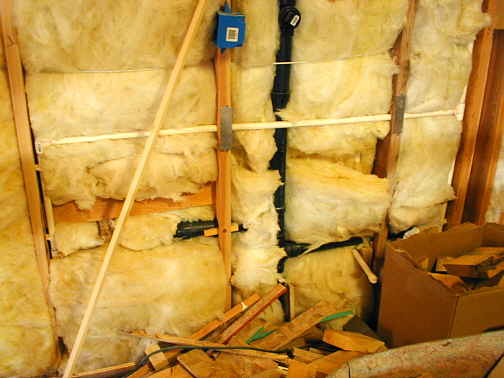
The picture above is typical of a lot of the plumbing. The vertical 2 inch black ABS pipe in the middle is a vent/drain pipe for the sink in the shop (black horizontal pipe to the right) and the kitchen sink (black horizontal pipe on the left).
The smaller white pipe is the CPVC pipe I used throughout the building for the hot/cold water lines. When it passes through studs and is within 1 1/2 inches of the stud surface you have to put on protective metal plates to protect the pipe from nails when you nail or screw on the finish wall.
.................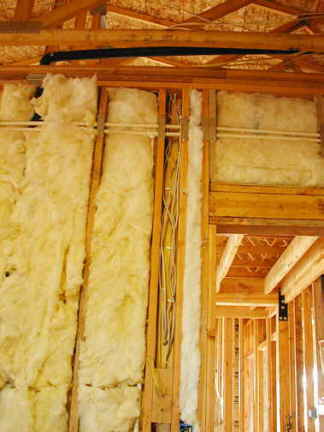
Here we can see at the top of the picture the top of the vent stack in the preceding picture and hot/cold pipes running along below it.
Also you can see a lot of wires running down the wall that go to the hall wall/north wall of the kitchen.
Yet to be installed are phone lines that will be in this same location. All the phone lines from around the house come to this one common point and there are two separate feeds coming different ways from the outside box. I also wired the phone lines with a line over to my store in plastic conduit that I buried between the two buildings. This will let me set up a phone in the house or store so I could hear the house phone ringing at the store or the store phone ringing at the house.
.................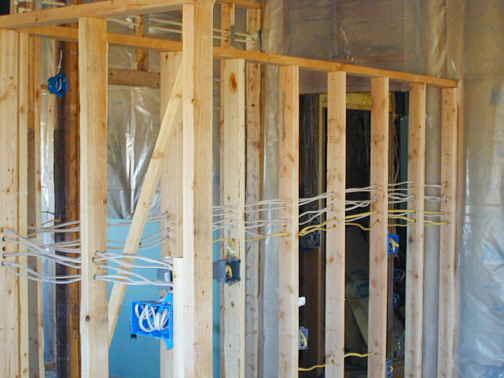
Some of the wires we saw in the last picture enter the short wall in the kitchen that is also the hall wall and supply power for the stove, frig, and outlets. Also there are wires for 3 different lighting circuits that can be turned on at the switch box in the foreground or at other areas of the house. One is for the hall, another for a walk through light for the living room area and the third for the kitchen. All of these can be turned off or on from two different locations.
.................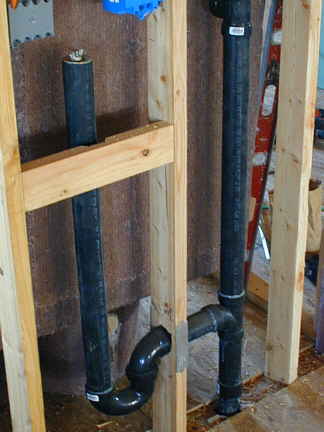
The drain for the cloths washer. Hot and cold water supply lines and a 220/240 outlet for the dryer was also added to this area.
.................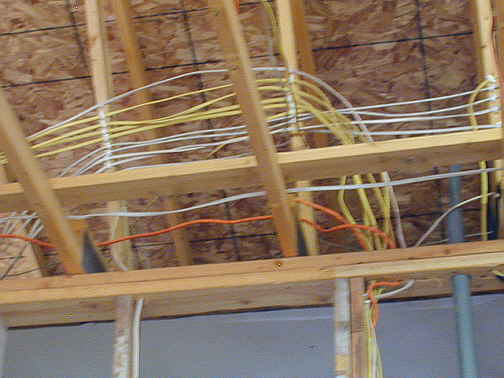
This is the wiring coming into the main breaker box from different areas of the house/shop.
.................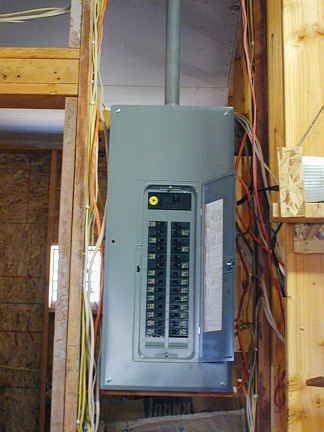
I've used all of the circuits in this main box except for 4. It is just inside the shop and easy to get to.
.................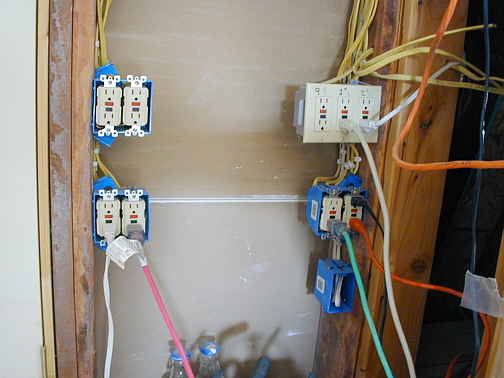
Right below the main box I have 9 GFI (ground fault interrupt) outlets plus one more in the bathroom. Each one of these GFI outlets is the first outlet on a 110/120 volt circuit in the house/shop. This outlet then protects all the other outlets following it on that circuit. This is cheaper than placing GFI breakers in the box and since they are all in one place and labeled if a circuit trips I just have to reset the GFI or the breaker in the box above. It also gave me circuits to run my extension cords off of while building and they will be useful in the shop later.
Code usually requires the GFI outlets only where water is present such as the bathroom, kitchen or outdoor circuits, but I feel they provide so much protection to you and your family I want all of my outlets protected by them and they aren't that expensive. You could go back into your existing wiring in your house and find the first outlet on your circuits and install them. Just remember where they are so you can reset them if they trip.
.................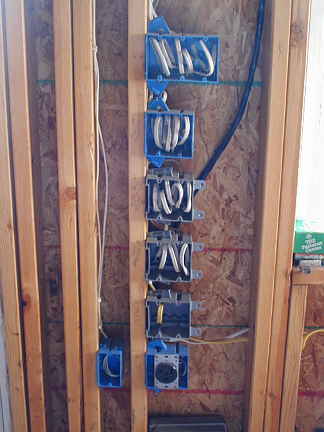
This is one of my more complicated wiring areas in the shop and is at the front door coming into the shop. The bottom outlet on the left is for a phone jack; on the right of it is a 220/240 outlet for a welder. Above that is a 110/120 duplex outlet. The next two boxes above that are for timers to control lighting for the front of the building and on the future fake gas pumps. The next box up will either turn the lights on/off for the front of the building and pumps or set them to turn on/off via the timers below. The top box is for switches for an outside overhead light, outside entrance light and for a light to walk through the shop at night, which can then be turned off at the other end of the shop or visa versa.
.................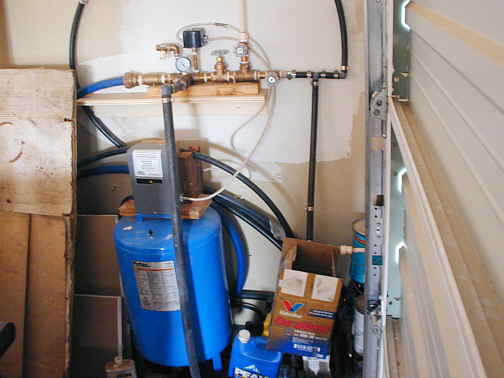
At the front of the shop next to the garage door is the pressure tank and controls for the pump in the well. Water comes in from the well when the water gets low in the pressure tank and fills it to 55 psi of pressure and then turns off. From the pressure tank the water flows through 2 different lines throughout the house and out to the garden.
The 220/240 breaker for the pump in the well is located at the main service entrance box outside the building where the meter is. I wired it that way so that in the event of fire the elect. can be turned off to the main box and all of the house/shop, but I could still leave the breaker on to the well pump to have some water to fight the fire.
.................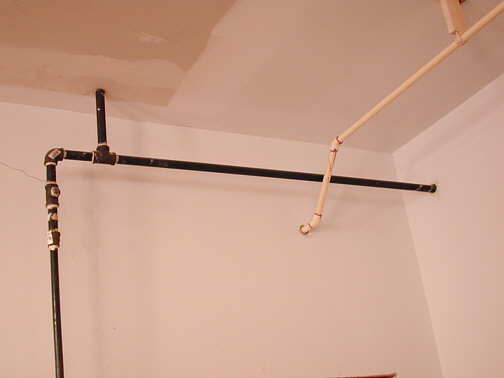
The above picture shows the cold water coming from the well pressure tank at the the other end of the shop (white
pipe). The black pipe is natural gas. I have city gas that comes to a meter on the north side of the building.
I then have a line that comes into the small storage room and on into the shop. It tees (see picture above) and
one line goes up (top line) and across the attic above the living quarters and comes down in the coat closet and
out the side of it and is for the gas stove with fake logs that you will see later. The other side of the tee (line
coming out of the tee and going down) is the line that goes into the north kitchen wall and to the gas stove in
the kitchen. On the two main runs I put in a couple more tees just in case I ever want to run a line into the bathroom
for a gas cloths dryer; or if I want to add a gas water heater, or a gas fired heater in the shop. I also made
these runs using larger pipe than I had to in case there is further needs in the future. Lastly I tried not to
have any runs (except for a few feet in the north kitchen wall) in walls. In case of a leak I wanted to be able
to smell it and I didn't want the gas trapped in a small enclosed area. This is just my thoughts on gas I don't
know if they are right or not.
.................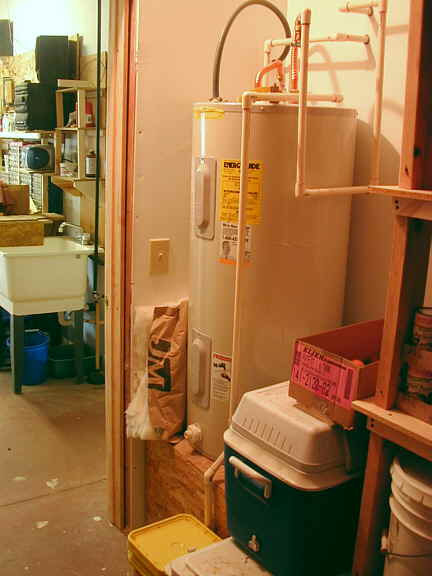
The water heater in the storage room off of the shop. The hot and cold lines on top of it first go up then down and then back up again. This provides a trap so that the hot water doesn't circulate out of it and waste hot water. The water heater is elect since I didn't want to vent a gas one outside. It is up on a box to meet code as it is suppose to be so far off the floor near the shop to avoid an explosion if fumes gathered in the shop.
If you look through the door and next to the deep sink you can see the black
gas line that comes down from near the ceiling (see previous picture). Next to the deep sink it then goes into
the wall and along the north wall of the kitchen for a few feet to the gas cooking stove.
..........................................................................Next Page
.................